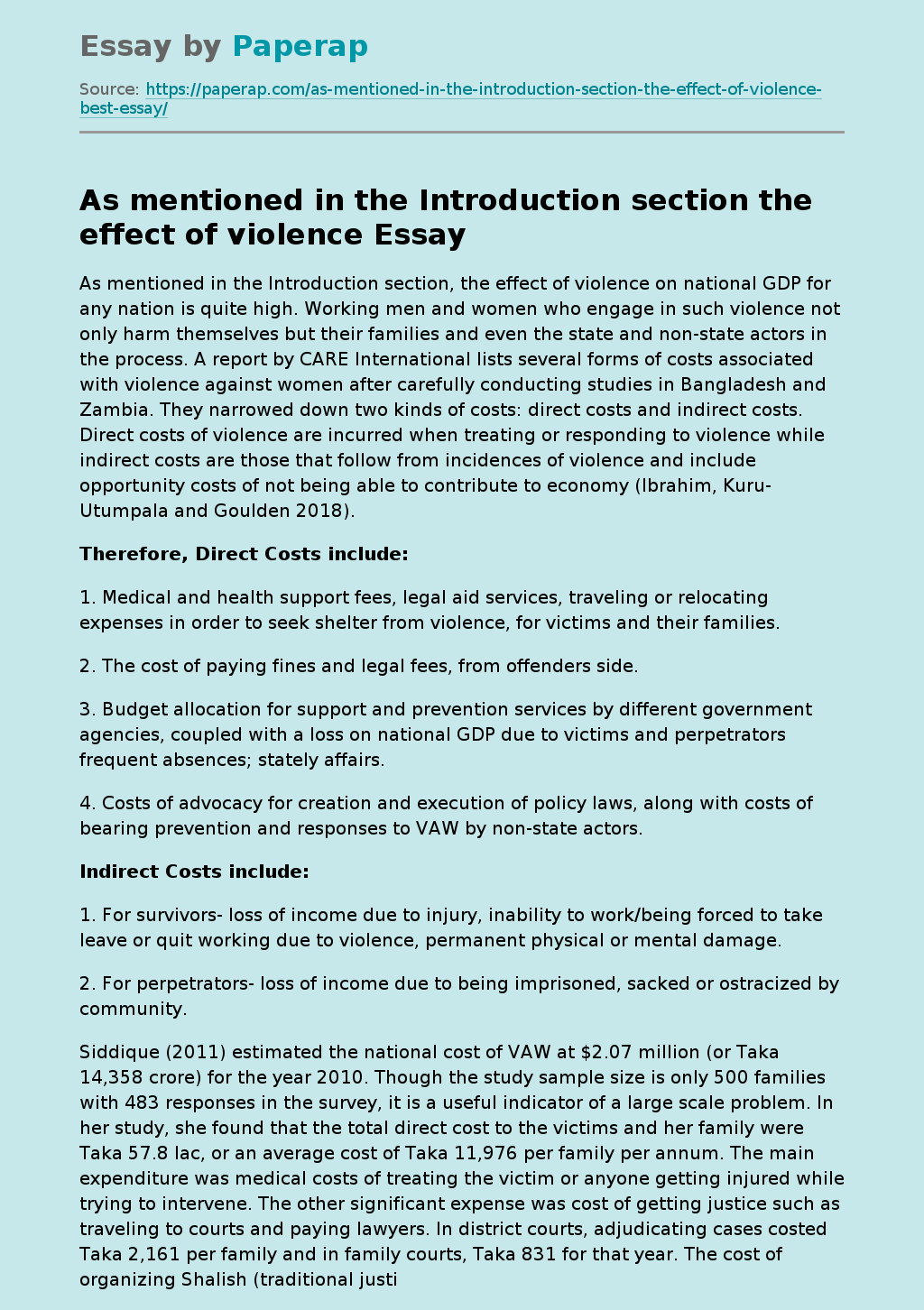National GDP in Bangladesh and Zambia
The following sample essay on “National GDP in Bangladesh and Zambia” explores the effect of violence on national GDP for any nation is quite high. Working men and women who engage in such violence not only harm themselves but their families and even the state and non-state actors in the process.
A report by CARE International lists several forms of costs associated with violence against women after carefully conducting studies in Bangladesh and Zambia. They narrowed down two kinds of costs: direct costs and indirect costs.
Direct costs of violence are incurred when treating or responding to violence while indirect costs are those that follow from incidences of violence and include opportunity costs of not being able to contribute to economy (Ibrahim, Kuru-Utumpala and Goulden 2018).
Therefore, Direct Costs include:
- Medical and health support fees, legal aid services, traveling or relocating expenses in order to seek shelter from violence, for victims and their families.
- The cost of paying fines and legal fees, from offenders side.
- Budget allocation for support and prevention services by different government agencies, coupled with a loss on national GDP due to victims and perpetrators frequent absences; stately affairs.
- Costs of advocacy for creation and execution of policy laws, along with costs of bearing prevention and responses to VAW by non-state actors.
Indirect Costs include:
- For survivors- loss of income due to injury, inability to work/being forced to take leave or quit working due to violence, permanent physical or mental damage.
- For perpetrators- loss of income due to being imprisoned, sacked or ostracized by community.
Siddique (2011) estimated the national cost of VAW at $2.07 million (or Taka 14,358 crore) for the year 2010. Though the study sample size is only 500 families with 483 responses in the survey, it is a useful indicator of a large scale problem. In her study, she found that the total direct cost to the victims and her family were Taka 57.8 lac, or an average cost of Taka 11,976 per family per annum. The main expenditure was medical costs of treating the victim or anyone getting injured while trying to intervene.
The other significant expense was cost of getting justice such as traveling to courts and paying lawyers. In district courts, adjudicating cases costed Taka 2,161 per family and in family courts, Taka 831 for that year. The cost of organizing Shalish (traditional justice system in rural areas) was also estimated at Taka 1,096.
The direct monetary cost to perpetrators and their family was estimated at Taka 50 lac, or an average of Taka 10,384 per family per annum, of which the greatest amount of expense was paying fines to the victim (Taka 7,987 on average). The average direct costs of relocating were estimated at Taka 1,184.
Taka 66 lac worth of wages were lost in the year 2010 as a result of permanent injury preventing victims from working. The average daily income for the victims in the sample were Taka 155 per day.
For the state, the expenditure of designing programs and activities for combating VAW was reportedly Taka 137.24 crore for the fiscal year 2010 or about 0.12 percent of total government budget (0.02% of estimated GDP). For non-state actors such as NGOs and CBOs, the estimated expenditure amount was around Taka 125-150 crore or 0.16% of total government budget (0.03% of GDP).
Theres a likelihood of error and estimation bias in the figures above due to victims and perpetrators releasing false information or incorrectly guessed amounts. The authors also admitted that intangible social costs and physical/mental costs associated with violence were difficult to quantify. These numbers are outdated and there is a major scope for farther research so as to depict current situation in 2019; nonetheless, I have included these figures for illustration purposes to draw out another major problem: the costs that poor men and women cannot bear to treat or prevent violence.
The survey respondents in the cases above were all from urban areas and from income generating households. However, a significant number of the population are unemployed and poverty-stricken in Bangladesh. Their income amount is negligible and that is where transfer programs can play instrumental role in preventing violence.
National GDP in Bangladesh and Zambia. (2019, Dec 14). Retrieved from https://paperap.com/as-mentioned-in-the-introduction-section-the-effect-of-violence-best-essay/

